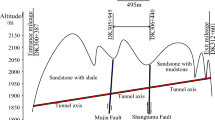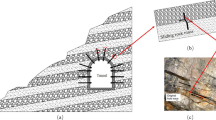Abstract
Anchoring temporary shelters is a repetitive and time-consuming task mostly accomplished by hand or handheld tools. Therefore, such anchors should be lightweight and easy to install. Experimental investigations on the effect of anchor geometry on ease of installation and uplift capacity of a double-helix anchor are presented. The double-helix anchor with 1.78 kN uplift capacity was tested on various soil types and conditions. Similar tests were carried out using the same anchors except that the helices were perforated for the first test and notched for the second test. The experimental setup was arranged to allow measurement of installation torque, installation time, and pullout load. It was observed that the uplift capacity and weight of the anchor dropped with the reduction in the surface area of the helices. The drop in the uplift capacities of the anchor with perforated helices and that with perforated and notched helices were 1.05 kN and 1.2 kN, respectively. Weight loss of 0.45 kg due to perforation and 0.88 kg due to notching were recorded. The minimum uplift capacity of the anchor with both perforated and notched helix was 1.84 kN. The ease of installation of the anchors was assessed based on the anchor driving torque and installation time. A general trend of reduction in the magnitude of anchor driving torque and installation time with the reduction in helix surface area was observed. Thus, perforating and notching helix surfaces could reduce the anchor weight and improve drivability.








Similar content being viewed by others
References
Cerato AB, Victor R (2009) Effects of long-term dynamic loading and fluctuating water table on helical anchor performance for small wind tower foundations. J Perform Constr Facil 23(4):251–261. https://doi.org/10.1061/(asce)cf.1943-5509.0000013
Hoyt RM, Clemence SP (1989) Uplift capacity of helical anchors in soil. In: Proceedings of the Twelfth International Conference on Soil Mechanics and Foundation Engineering, 2:1019–1022
Engineering Design Manual (2014) Helical Anchors Inc., EDM Rev 02, 1–55 http://www.helicalanchorsinc.com/wp-content/uploads/2015/06/Helical-Anchor-Inc-Engineering-Manual-Rev-02.pdf. Accessed 5 Oct 2019
Tang C, Phoon KK (2016) Model uncertainty of cylindrical shear method for calculating the uplift capacity of helical anchors in clay. Eng Geol 207:14–23. https://doi.org/10.1016/j.enggeo.2016.04.009
Vesic AS (1971) Breakout Resistance of Objects Embedded in Ocean Bottom. ASCE J Soil Mech Found Div 97(9):1183–1205
Meyerhof GG (1973) Uplift resistance of inclined anchors and piles. In: Proceedings of the 8th International Conference on Soil Mechanics and Foundation Engineering, Rotterdam, Netherlands 2 (1):167–172.
Das BM (1978) Model tests for uplift capacity of foundations in clay. Soils Found 18(2):17–24
Das BM (1980) A procedure for estimation of ultimate uplift capacity of foundations in clay. Soils Found 20(1):77–82
Wang D, Merifield RS, Gaudin C (2013) Uplift behaviour of helical anchors in clay. Can Geotech J 50(6):575–584. https://doi.org/10.1139/cgj-2012-0350
Lutenegger AJ (2009) Cylindrical shear or plate bearing? Uplift behavior of multi-helix screw anchors in clay. ASCE 185:456–463 Geotechnical Special Publications
Mitsch MP, Clemence SP (1985) Uplift Behavior of Anchor Foundations in Sand. ASCE, Reston
Mooney JS, Adamczak SJ, Clemence SP (1985) Uplift capacity of helix anchors in clay and silt. In: Proceedings of Uplift Behavior of Anchor Foundations in Soil, ASCE 48–72.
Rao SN, Prasad YVSN, Shetty MD (1991) The behavior of model screw piles in cohesive soils. Soils Found 31(2):35–50
Ghaly A, Hanna A, Hanna M (1991) Uplift behavior of screw anchors in sand. I: dry sand. J Geotech Eng 117(5):733–793
Schiavon JA, Tsuha CHC, Thorel L (2017) Cyclic and post-cyclic monotonic response of a single-helix anchor in sand. Geotech Lett 7(1):11–17. https://doi.org/10.1680/jgele.16.00100
Newgard JT, Schneider J, Thompson DJ (2015) Cyclic response of shallow helical anchors in a medium dense sand. In: Meyer (ed) Frontiers in Offshore Geotechnics III. Taylor & Francis Group, London, pp 913–918. https://doi.org/10.1201/b18442-131
Lutenegger AJ, Smith BL, Kabir MG (1988) Use of in situ tests to predict performance of multihelix anchors. In: ASCE Proceedings Special Topics in Foundations, Nashville
Narasimha Rao S, Prasad YVSN, Veeresh C (1993) Behavior of embedded model screw anchors in soft clays. Geotechnique 43(4):605–614
Merifield RS (2011) Ultimate uplift capacity of multiplate helical type anchors in clay. J Geotech Geoenvironm Eng 137(7):704–716. https://doi.org/10.1061/(Asce)Gt.1943-5606.0000478
Demir A, Ok B (2015) Uplift response of multi-plate helical anchors in cohesive soil. Geomechan Eng 8(4):615–630. https://doi.org/10.12989/gae.2015.8.4.615
Murray EJ, Geddes JD (1987) Uplift of anchor plates in sand. J Geotech Eng ASCE 113(3):202–215. https://doi.org/10.1061/(Asce)0733-9410(1987)113:3(202)
Ilamparuthi K, Muthukrishnaiah K (1999) Anchors in sand bed: delineation of rupture surface. Ocean Eng 26(12):1249–1273. https://doi.org/10.1016/S0029-8018(98)00034-1
Healy KA (1971) Pullout resistance of anchors buried in sands. J Soil Mechan Found Div ASCE 97(11):1615–1622
Ranjan G, Kaushal YP (1977) Load-deformation characteristics of model anchors under horizontal pull in sand. Goetechn Eng Bangk Thail 8:65–78
Hanna AM, Ranjan G (1992) Pullout-displacement of shallow vertical anchor plates. Indian Geotech J 22(1):55–62
Hanna A, Ayadat T, Sabry M (2007) Pullout resistance of single vertical shallow helical and plate anchors in sand. Geotechn Geol Eng 25(5):559–573. https://doi.org/10.1007/s10706-007-9129-4
Ghosh P, Samal S (2017) Interaction effect of group of helical anchors in cohesive soil using finite element analysis. Geotechn Geol Eng 35(4):1475–1490. https://doi.org/10.1007/s10706-017-0188-x
Buhler RT, Cerato AB (2010) Design of dynamically wind-loaded helical piers for small wind turbines. J Perform Constr Facil 4:417–426. https://doi.org/10.1061/(ASCE)CF.1943-5509.0000119
Rao SN, Prasad YVSN (1993) Estimation of uplift capacity of helical anchors in clays. J Geotech Eng ASCE 119(2):352–357. https://doi.org/10.1061/(Asce)0733-9410(1993)119:2(352)
Aouadi F, Ghebrab TT, Soroushian P (2018) Reliable and convenient multi-helix soil anchor for deployable structures. Geotechn Geol Eng 36:2611–2623
Minimum Design Loads for Buildings and Other Structures (2010) ASCE 7-10, Americal Society of Civil Engineers (ASCE), Ch26
Acknowledgements
The authors are thankful to the U.S. Army for support of this project under Contract No. DAAD-16–03-C-0027 and DAAD-16–02-C-0027. The authors are also thankful to Ghalam Sarwar for his contribution to the experimental work performed in the project.
Author information
Authors and Affiliations
Corresponding author
Rights and permissions
About this article
Cite this article
Aouadi, F., Ghebrab, T., Soroushian, P. et al. Effect of Helical Surface Area on the Performance of a Multi-Helix Anchor. Int J Civ Eng 18, 439–448 (2020). https://doi.org/10.1007/s40999-019-00490-7
Received:
Revised:
Accepted:
Published:
Issue Date:
DOI: https://doi.org/10.1007/s40999-019-00490-7




